Bookish & Craftastic Advent Ideas
The countdown to Christmas is about to begin, so here are some of my all-time favorite book-related and crafty ideas for a fun and meaningful Advent!
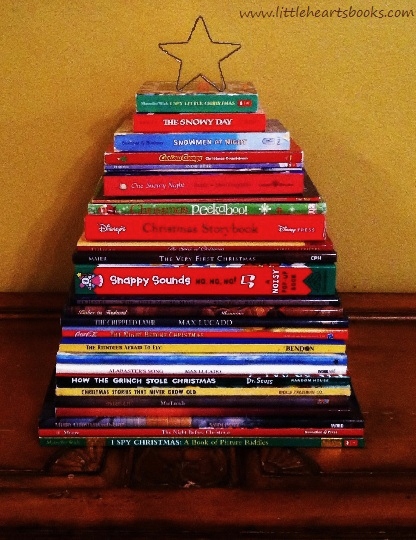 Book Advent~Every year I put away all of our Christmas and winter-themed books and then pull them out on the 1st of December to make a Picturebook Christmas Tree. We read one each evening for a bedtime book Advent tradition that my little bookworms look forward to year after year.
Book Advent~Every year I put away all of our Christmas and winter-themed books and then pull them out on the 1st of December to make a Picturebook Christmas Tree. We read one each evening for a bedtime book Advent tradition that my little bookworms look forward to year after year.
Another idea (from Detail Gal Blog) is to wrap books and put them under the tree so that as you read them and the space under the tree empties, excitement for Christmas morning builds!
Wrapping just the covers of picturebooks and lining them up on a mantle or bookshelf like a  colorful little Christmas tree forest is another awesome Advent idea from Reading Confetti!
colorful little Christmas tree forest is another awesome Advent idea from Reading Confetti!
Here are some Christmas and winter-themed book suggestions:
Source: lifeatthezoo.com via Melissa Taylor, ImaginationSoup.net on Pinterest
Source: holyspiritledhomeschooling.net via Melissa Taylor, ImaginationSoup.net on Pinterest
And these free, printable Advent activity cards…
Source: addapinch.com via Melissa Taylor, ImaginationSoup.net on Pinterest
or these service-themed Advent cards…
Source: aliedwards.com via Melissa Taylor, ImaginationSoup.net on Pinterest
would be awesome with these vintage-looking library book pockets.
Source: notonthehighstreet.com via L.R. on Pinterest
This year we are making an ornament a day to give as gifts to family and friends in what I hope will become another fun and creative Advent tradition for our family. If you want to give it a try, too, you can find some cute ornament craft ideas here.
And for more ideas about how to make the holiday season fun-filled and meaningful, as well as keeping the joy and wonder of childhood alive for your little ones year round:
In a twist on the Advent theme, here is A Very Toddler Christmas~24 Tips for a Safe, Stress-Free & Jolly Holiday
The Spirit of Christmas… The Great Santa Claus Debate
Making gratitude and generosity a standard of life… 7 Tips and Traditions to Make Giving a Standard of Living
The Reason for the Season… Celebrating Jesus with a Santa Claus Christmas
A happy childhood sends a child into adulthood with a baggage of confidence and kindness instead of disillusionment and anger. 200 Ways to Bless Your Children with a Happy Childhood
The human brain needs time to process, categorize, prioritize, analyze, and otherwise make sense of all of the trillions of bits of information that it receives each day. Non-structured playtime for children functions much like sleep does for adults, giving their brains the time and space they need to move short-term memory to long-term learning. 25 Reasons NOT to Keep Children Busy
In the world of a child wonders are as simple as sticks and sheets, leaves and books, boxes and giggles, and the promise in a rainy day. The Seven Wonders of the World of Childhood
Children who love to read…READ! Engaging children’s hearts in the wonder of reading instead of just training their minds in its mechanics. Raising Bookworms
From hitting to defiance to tantrums to testing the boundaries and more, here are gentle parenting tools, tips, and techniques…Practical Gentle Discipline
 Award-winnning author, L.R.Knost, is the founder and director of the children's rights advocacy and family consulting group, Little Hearts/Gentle Parenting Resources, and Editor-in-Chief of Holistic Parenting Magazine. Books by L.R.Knost include Whispers Through Time: Communication Through the Ages and Stages of Childhood ; Two Thousand Kisses a Day: Gentle Parenting Through the Ages and Stages ; The Gentle Parent: Positive, Practical, Effective Discipline ; and Jesus, the Gentle Parent: Gentle Christian Parenting the first four books in the Little Hearts Handbook gentle parenting series, and children’s picture books Petey’s Listening Ears and the soon-to-be-released Grumpykins series.
Award-winnning author, L.R.Knost, is the founder and director of the children's rights advocacy and family consulting group, Little Hearts/Gentle Parenting Resources, and Editor-in-Chief of Holistic Parenting Magazine. Books by L.R.Knost include Whispers Through Time: Communication Through the Ages and Stages of Childhood ; Two Thousand Kisses a Day: Gentle Parenting Through the Ages and Stages ; The Gentle Parent: Positive, Practical, Effective Discipline ; and Jesus, the Gentle Parent: Gentle Christian Parenting the first four books in the Little Hearts Handbook gentle parenting series, and children’s picture books Petey’s Listening Ears and the soon-to-be-released Grumpykins series.
A Very Toddler Christmas~24 Tips for a Safe, Stress-Free & Jolly Holiday
[By L.R.Knost, best-selling author of The Gentle Parent: Positive, Practical, Effective Discipline; Whispers Through Time: Communication Through the Ages and Stages of Childhood; Two Thousand Kisses a Day: Gentle Parenting Through the Ages and Stages; and Jesus, the Gentle Parent: Gentle Christian Parenting available on Amazon and through other major retailers.]
*********************
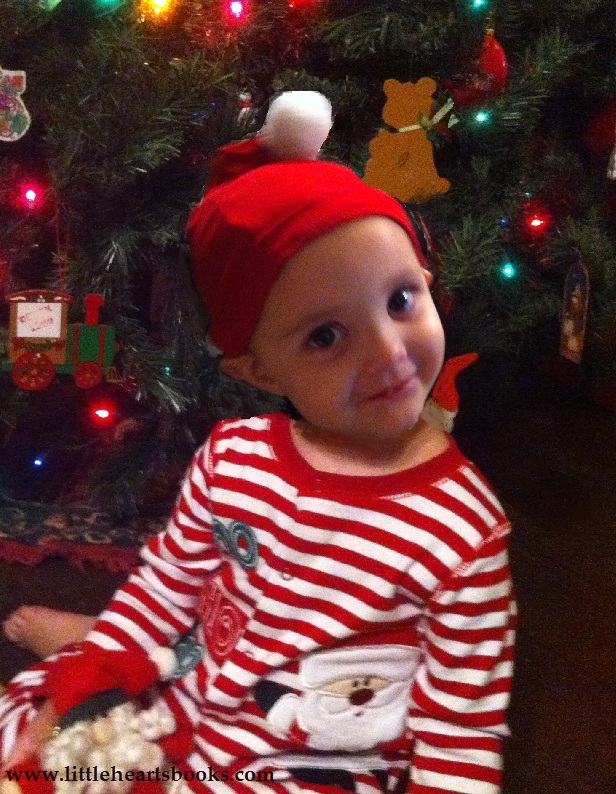 What do you get when you cross a curious toddler with a Christmas tree covered with glittering, dangling ‘toys’ and enticing, shiny lights? At the very least, a season of toddler chasing and redirecting, and at the worst a season of shattered-glass hazards and tree-scaling, toppling nightmares. So what’s a parent to do? Must we scrap the tree so we can have a merry Christmas while we have little ones in the house? Not at all!
What do you get when you cross a curious toddler with a Christmas tree covered with glittering, dangling ‘toys’ and enticing, shiny lights? At the very least, a season of toddler chasing and redirecting, and at the worst a season of shattered-glass hazards and tree-scaling, toppling nightmares. So what’s a parent to do? Must we scrap the tree so we can have a merry Christmas while we have little ones in the house? Not at all!
Here is an Advent list with a twist…24 Christmas safety tips for parents with tiny people who love to explore:
 1.) A Christmas tree plopped down right in the middle of a child’s playspace (i.e. family room, living room, den) is just too much temptation for any little person, so one solution is to place the tree in a lesser-used room such as a study or office or even a covered porch where the tree can be seen but is less accessible to little explorers.
1.) A Christmas tree plopped down right in the middle of a child’s playspace (i.e. family room, living room, den) is just too much temptation for any little person, so one solution is to place the tree in a lesser-used room such as a study or office or even a covered porch where the tree can be seen but is less accessible to little explorers.
2.) Another option is to place the Christmas tree in a play yard like the one pictured to keep the tree safe while still having it in a central location in the house for everyone to enjoy.
3.) A tabletop tree is also an option. Keep the tree away from the edges and watch out for dangling tree skirts and light cords so little hands can’t pull the tree down on top of little heads.
4.) For families like ours who have lots of little ones toddling around year after year, a child-proof tree may be the answer. We used fishline to anchor our tree to the ceiling after one tiny climber toppled the tree over on herself a few times. Non-breakable ornaments (homemade ornaments are great 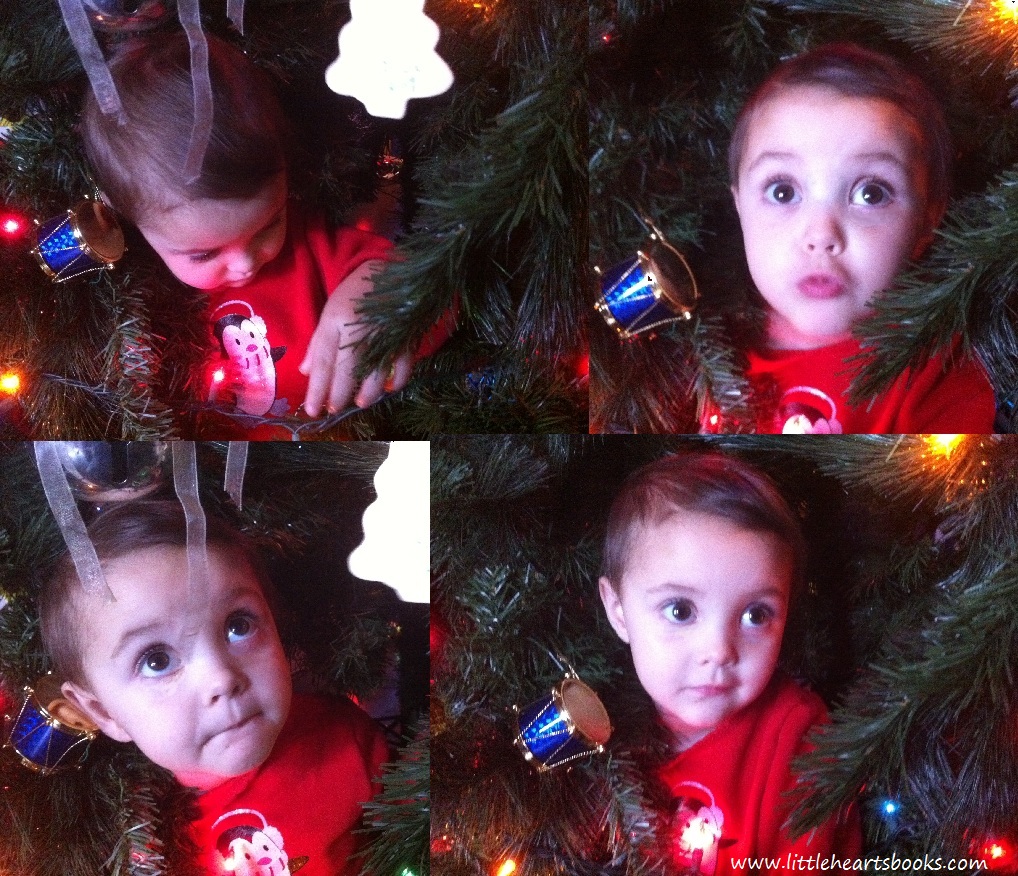 alternatives) tied to the tree with ribbons instead of metal hooks (choking hazard!) are the solution to our current little spelunker who loves to crawl under the Christmas tree and lay looking up at the sparkling lights from her little hidey-hole.
alternatives) tied to the tree with ribbons instead of metal hooks (choking hazard!) are the solution to our current little spelunker who loves to crawl under the Christmas tree and lay looking up at the sparkling lights from her little hidey-hole.
5.) Be sure to check that your artificial tree is fire-rated or your real tree is fresh (i.e. easily bendable branches, no dropping needles) and keep your real tree well-watered to reduce fire danger.
6.) Always check lights for broken, loose, or missing bulbs, and make sure wires aren’t frayed and sockets aren’t cracked. Turn lights off when leaving your home or going to bed.
7.) For outdoor lighting/decorating, be sure to use extension cords rated for outdoor use, and don’t overload the outlet by stringing together more lights than the instructions allow. Elevate cords to avoid them sitting in water or on dry leaves. Have lights on a timer or turn lights out when leaving your home or going to bed.
8.) When decorating, place figurines and keepsakes out of reach of little hands to avoid constantly chasing giggling toddlers who find your reaction to their snatch-and-run game a great source of holiday entertainment.
9.) Avoid decorating with real holly or mistletoe in areas accessible to small children, as both are toxic if eaten.
10.) Never decorate your tree with candles, and keep candles separated from pine branches on tabletops and mantles by placing them in deep glass votives. Never leave a small child alone in a room with a burning candle.
11.) Keep snow sprays out of reach as they can be toxic if inhaled and can cause injury if sprayed into eyes.
12.) When entertaining, keep hot plates away from the edges of tables and remind guests not to leave hot or alcoholic beverages within reach of small children.
13.) House guests may not be used to having small children around, so be extra vigilant about medicine bottles, unattended purses, open luggage, and other dangers that may visit along with your guests.
14.) When purchasing gifts, check labels for age recommendations. Keep in mind that even if you think a little one is advanced enough to enjoy a toy that is recommended for an older child, the toy may contain choking hazards or other dangers to a small child.
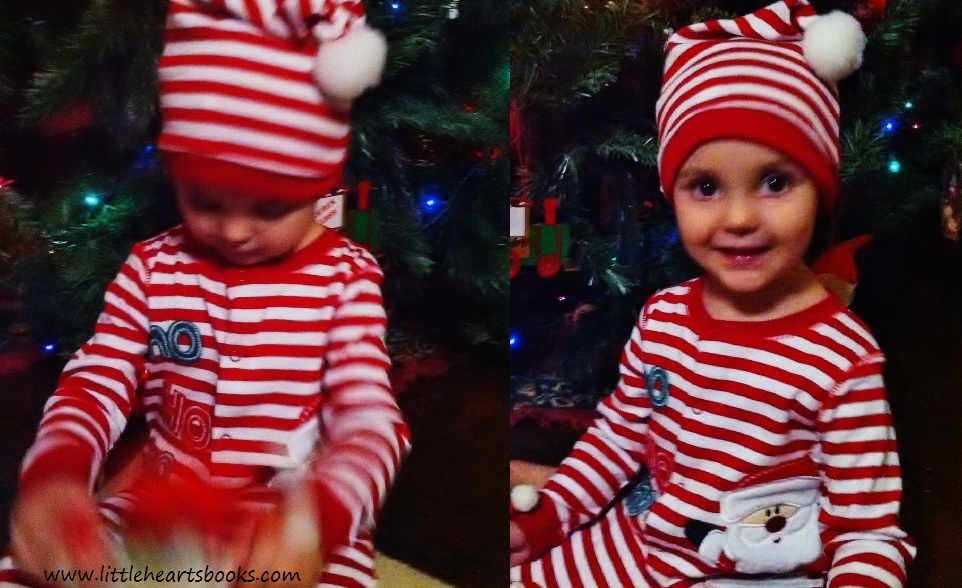 15.) Unless you like wrapping presents over and over and…well, you get the picture, avoid setting wrapped packages out under the tree if the tree is accessible to small children. Keeping your expectations in line with your child’s developmental stage is a key element to avoiding conflict in your parent/child relationship and making your holidays less stressful and more enjoyable!
15.) Unless you like wrapping presents over and over and…well, you get the picture, avoid setting wrapped packages out under the tree if the tree is accessible to small children. Keeping your expectations in line with your child’s developmental stage is a key element to avoiding conflict in your parent/child relationship and making your holidays less stressful and more enjoyable!
16.) In the flurry of gift opening on Christmas morning, small objects from ripped open packages (like the 42 little plastic tabs to hold a $5 rattle in a cardboard box!) can end up scattered amongst the toys and boxes and paper, creating a sea of choking hazards. Keep a big box handy to throw packaging and wrapping paper into, and choose one or two toys to remove from their packaging for immediate play while putting the other opened presents away in another box to be opened later.
17.) Never let children throw wrapping paper into the fireplace, as this can cause a dangerous flash fire.
18.) Keep a close watch on your little one’s diet throughout the holidays. In the busyness of the season, nutrition often takes a backseat to convenience, and an overload of junk foods and sweets can cause tummy aches and crankiness which won’t help them or you to have a jolly holiday.
19.) Another nutritional danger of the season is unintentional weaning. If you’re nursing a little one, the constant changes in schedule, the busyness, the stress, and the baby being passed from one relative to another can result in missed feedings and reduced milk supply. Making a conscious effort to take regular nursing breaks in a quiet room with your little nursling will give both of you a chance to reconnect and de-stress a bit and keep your nursing relationship intact.
20.) Also, be very aware of your little one’s sleep patterns during the holiday season. All of the disturbances mentioned in #19 can wreak havoc on a small child’s sleep schedule and, along with the almost inevitable over-stimulation of the music, lights, and visitors, that can make the holidays a miserable time for a little person.
21.) Fireplaces should be regularly inspected to prevent chimney fires, and protective fire-screens and/or baby gates should be used to keep little ones safe.
22.) Space heaters are a well-known fire hazard. Make sure you are using them according to the manufacturer’s specifications and that they are in good working order. Never leave a small child unattended in a room with a space heater.
23.) Keep in mind that, while you know and love those visiting relatives your little one has never met, expecting a small child to instantly let a person who is a total stranger to them hold and kiss and play with them is unrealistic. If we want our children to exercise restraint and caution with random strangers at the 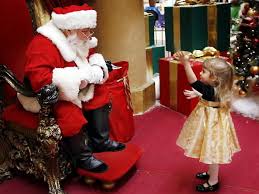 park/mall/etc., we need to allow them to set limits they are comfortable with when it comes to physical contact and interaction with the ‘strangers’ in our homes, as well.
park/mall/etc., we need to allow them to set limits they are comfortable with when it comes to physical contact and interaction with the ‘strangers’ in our homes, as well.
24.) And, last but certainly not least, while pictures of their little ones with Santa may be every parent’s heart’s desire, small children often don’t share that desire. Instead of forcing your child to sit in a strange man’s lap (not exactly a precedent we want to set for our children!), if your child isn’t comfortable with the idea, get creative and try getting pictures of your toddler standing near Santa while he plays peek-a-boo with them or try kneeling on one knee next to Santa, yourself, with your little one on your other knee. You never know, those pictures may end up being your all-time favorites!
~~~~~~~~~~~~~~
More ideas about how to make the holiday season fun-filled and meaningful, as well as keeping the joy and wonder of childhood alive for your little ones year round:
The Spirit of Christmas… The Great Santa Claus Debate
Making gratitude and generosity a standard of life… 7 Tips and Traditions to Make Giving a Standard of Living
The Reason for the Season… Celebrating Jesus with a Santa Claus Christmas
A happy childhood sends a child into adulthood with a baggage of confidence and kindness instead of disillusionment and anger. 200 Ways to Bless Your Children with a Happy Childhood
The human brain needs time to process, categorize, prioritize, analyze, and otherwise make sense of all of the trillions of bits of information that it receives each day. Non-structured playtime for children functions much like sleep does for adults, giving their brains the time and space they need to move short-term memory to long-term learning. 25 Reasons NOT to Keep Children Busy
In the world of a child wonders are as simple as sticks and sheets, leaves and books, boxes and giggles, and the promise in a rainy day. The Seven Wonders of the World of Childhood
Children who love to read…READ! Engaging children’s hearts in the wonder of reading instead of just training their minds in its mechanics. Raising Bookworms
From hitting to defiance to tantrums to testing the boundaries and more, here are gentle parenting tools, tips, and techniques. Practical, Gentle, Effective Discipline
 Award-winnning author, L.R.Knost, is the founder and director of the children's rights advocacy and family consulting group, Little Hearts/Gentle Parenting Resources, and Editor-in-Chief of Holistic Parenting Magazine. Books by L.R.Knost include Whispers Through Time: Communication Through the Ages and Stages of Childhood ; Two Thousand Kisses a Day: Gentle Parenting Through the Ages and Stages ; The Gentle Parent: Positive, Practical, Effective Discipline ; and Jesus, the Gentle Parent: Gentle Christian Parenting the first four books in the Little Hearts Handbook gentle parenting series, and children’s picture books Petey’s Listening Ears and the soon-to-be-released Grumpykins series.
Award-winnning author, L.R.Knost, is the founder and director of the children's rights advocacy and family consulting group, Little Hearts/Gentle Parenting Resources, and Editor-in-Chief of Holistic Parenting Magazine. Books by L.R.Knost include Whispers Through Time: Communication Through the Ages and Stages of Childhood ; Two Thousand Kisses a Day: Gentle Parenting Through the Ages and Stages ; The Gentle Parent: Positive, Practical, Effective Discipline ; and Jesus, the Gentle Parent: Gentle Christian Parenting the first four books in the Little Hearts Handbook gentle parenting series, and children’s picture books Petey’s Listening Ears and the soon-to-be-released Grumpykins series.
The Taming of the Tantrum: A Toddler’s Perspective
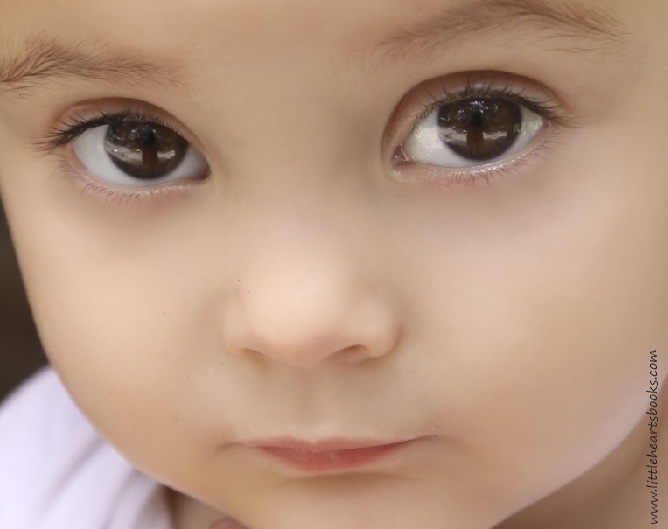 [From Whispers Through Time: Communication Through the Ages and Stages of Childhood by L.R.Knost. Two Thousand Kisses a Day: Gentle Parenting Through the Ages and Stages and The Gentle Parent: Positive, Practical, Effective Discipline also available on Amazon and through other major retailers.]
[From Whispers Through Time: Communication Through the Ages and Stages of Childhood by L.R.Knost. Two Thousand Kisses a Day: Gentle Parenting Through the Ages and Stages and The Gentle Parent: Positive, Practical, Effective Discipline also available on Amazon and through other major retailers.]
So parents, here’s the scoop on tantrums:
They’re your fault.
Okay, okay, so maybe my toddlerhood contributes to them a teensy-weensy bit, but seriously…
You with the obsession with brushing teeth and bedtimes and matching clothes, enough already! Does it ever even occur to you that there’s another person (Yes, I am an actual separate person from you. Remember that whole cutting of the umbilical cord thing?) who might have an opinion about what goes in my mouth or when I’m tired or not or what I want to wear?
And you, the one who thinks carrots and kale are food. Really? You have all kinds of opinions about what tastes good and what doesn’t, but I’m not allowed to have any?
And don’t even get me started on the rush-rush, hurry-up craziness that has me being snatched up in the middle of my most fantastic block tower ever and strapped into a torture device (Btw, where’s your carseat?!?) and dragged from one place to another right through snack time. I can’t have an agenda? Don’t my interests mean anything?
Okay, so maybe I don’t know everything yet, but how am I going to learn if you just force these issues instead of communicating with me about things? That whole learning by osmosis thing (a.k.a. passive learning) didn’t work for you in college, and it won’t work with me, either.
You keep going on and on and ooooon about wanting me to listen. “Why won’t you listen?” “If you’d listen for once!” “Would you just listen to me?!?” I’ve got three words for you…
Two. Way. Street.
Maybe instead of that whole failed learning by osmosis experiment you keep trying (You do know the definition of insanity is doing the same thing over and over again expecting a different result, right? Okay, okay, just checking!) you could read the research and find out that I learn by active engagement (two-way conversation!) and imitation. Yep, that’s right. I learn from what you do, not just what you say.
So here’s the deal…
Want me to learn to listen? Then listen to me. Listen and respond to my cries when I’m a baby. Listen and reply to my babbling attempts at talking when I’m a toddler. Listen to my whining and respond patiently when I’m a preschooler. (I know it’s annoying, but whining is my last step, kind of like your ‘last nerve’ you complain I’m stomping on, before I have a meltdown. It’s my last-ditch effort to hold on to the tiny bit of self-control I’ve learned so far in my short life!) Listen and actually pay attention (a.k.a eye contact!) to my endless stories about snails when I’m in middle childhood and to my endless complaints and dramas when I’m in my teen years.
Want me to learn respect? Then show me respect. Show me that you respect my personal space by explaining the things you’re doing to me like changing my diaper or strapping me into a carseat. Show me that you respect others by not talking about them behind their backs (Yes, I can and do hear you!) or yelling at them on the road. Show me that you respect my opinions by asking for them and accommodating them when you can. (I know you won’t always be able to, but the times you do will help me to accept the times you can’t.)
Want me to learn compassion? Then show me compassion. Respond kindly and gently when I’m upset or angry or just out-of-sorts. Stay close when my emotions overwhelm me and I have a meltdown moment. (I need your presence and compassion the most when I seem to deserve it or even want it the least!) And model compassion by treating others kindly in front of me.
Want me to learn self-control? (This is a big one!) Then show me self-control. Take a parental time-out when you get tired or overwhelmed or angry so I learn how to handle those big emotions. Count to ten and take some deep breaths instead of yelling or hitting. And pace yourself in this big world. I need to learn that it’s okay to take care of myself and not feel like I have to fill every moment with plans and schedules and agendas. I’ll learn that from watching you choose wisely from the many opportunities and pressures life will offer.
Okay, so to wrap this up. My tantrums don’t just come out of nowhere. They are the result of tiredness, hunger, frustration, anger, etc. You can prevent them, or at least minimize them, by keeping me fed and rested, by paying attention to my preferences, interests, and attempts to communicate, and by communicating kindly and patiently with me about upcoming changes or things I might not like. And keep in mind, I’m always watching and absorbing everything that goes on around me, so make sure you’re living what you want me to learn!
Related posts:
Practical, Gentle, Effective Discipline
When Things Get Physical: Hitting, Throwing, Kicking, and Biting
Testing the Boundaries~What’s a Parent to Do?
Toddlers, Tantrums, and Time-In’s, Oh My!
Parenting a Strong-Willed Child
Spare the Rod: The Heart of the Matter
Easy Peasy DIY Parenting Tools
To a Toddler Sharing is a 4 Letter Word~MINE!
 Award-winnning author, L.R.Knost, is the founder and director of the children's rights advocacy and family consulting group, Little Hearts/Gentle Parenting Resources, and Editor-in-Chief of Holistic Parenting Magazine. Books by L.R.Knost include Whispers Through Time: Communication Through the Ages and Stages of Childhood ; Two Thousand Kisses a Day: Gentle Parenting Through the Ages and Stages ; The Gentle Parent: Positive, Practical, Effective Discipline ; and Jesus, the Gentle Parent: Gentle Christian Parenting the first four books in the Little Hearts Handbook gentle parenting series, and children’s picture books Petey’s Listening Ears and the soon-to-be-released Grumpykins series.
Award-winnning author, L.R.Knost, is the founder and director of the children's rights advocacy and family consulting group, Little Hearts/Gentle Parenting Resources, and Editor-in-Chief of Holistic Parenting Magazine. Books by L.R.Knost include Whispers Through Time: Communication Through the Ages and Stages of Childhood ; Two Thousand Kisses a Day: Gentle Parenting Through the Ages and Stages ; The Gentle Parent: Positive, Practical, Effective Discipline ; and Jesus, the Gentle Parent: Gentle Christian Parenting the first four books in the Little Hearts Handbook gentle parenting series, and children’s picture books Petey’s Listening Ears and the soon-to-be-released Grumpykins series.
7 Tips and Traditions to Make Giving a Standard of Living
[By L.R.Knost, best-selling author of The Gentle Parent: Positive, Practical, Effective Discipline, Whispers Through Time: Communication Through the Ages and Stages of Childhood and Two Thousand Kisses a Day: Gentle Parenting Through the Ages and Stages available on Amazon and through other major retailers.]
~~~~~~~~~~~~~~~~~~~~~
As we head toward Thanksgiving and Christmas this year, I wanted to share some of the wonderful ideas I’ve been gathering about making gratitude and giving a standard of daily living along with a celebrated part of the holidays. Some of these ideas are ones we’ve done in our family for years, and some are new ideas I’m excited to try out!
 1.) I believe the best way to raise generous, empathetic human beings is by being a generous, empathetic human being. So the first and most simple idea is just to live what we want our children to learn. If we want our children to be kind, we need to treat them and everyone else kindly. If we want them to be thankful, we should thank them regularly for the things they do and the blessings the are to us and to the world and let them see us being thankful for our own blessings. If we want them to be generous, we need to share what we have freely with them and let them see us giving to others. And if we want them to have the desire to serve, we must meet their needs fully so they will be free from focusing on trying to get their own needs met, and we should let them see us serving others on a regular basis.
1.) I believe the best way to raise generous, empathetic human beings is by being a generous, empathetic human being. So the first and most simple idea is just to live what we want our children to learn. If we want our children to be kind, we need to treat them and everyone else kindly. If we want them to be thankful, we should thank them regularly for the things they do and the blessings the are to us and to the world and let them see us being thankful for our own blessings. If we want them to be generous, we need to share what we have freely with them and let them see us giving to others. And if we want them to have the desire to serve, we must meet their needs fully so they will be free from focusing on trying to get their own needs met, and we should let them see us serving others on a regular basis.
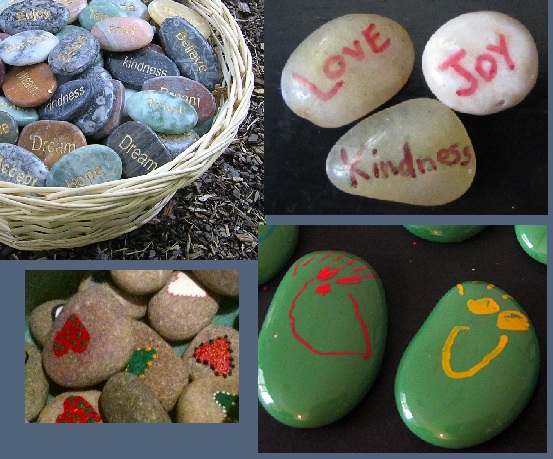 2.) I absolutely love the idea of painting ‘Blessing Stones’ and scattering them around town for people to find. They don’t serve any specific purpose, and you’ll probably never know if they’ve been found. They’re simply a little blessing to brighten someone’s day unexpectedly. Your children can stamp or write words or even Bible verses on smooth stones, or they can paint hearts or smiley faces on them. You can even pray over the stones with your children first if you like, then simply take a walk around town and let your little ones ‘hide’ the rocks. What a fun way to share some smiles!
2.) I absolutely love the idea of painting ‘Blessing Stones’ and scattering them around town for people to find. They don’t serve any specific purpose, and you’ll probably never know if they’ve been found. They’re simply a little blessing to brighten someone’s day unexpectedly. Your children can stamp or write words or even Bible verses on smooth stones, or they can paint hearts or smiley faces on them. You can even pray over the stones with your children first if you like, then simply take a walk around town and let your little ones ‘hide’ the rocks. What a fun way to share some smiles!
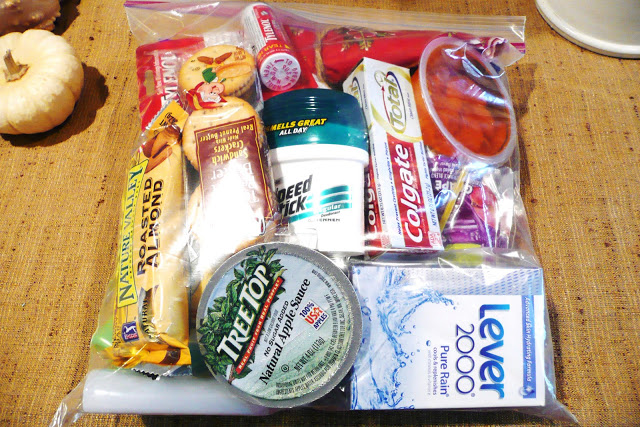 3.) Another idea I fell in love with was ‘Blessing Bags.’ The idea is to fill gallon sized ziploc bags with essentials such as soap, deodorant, toothpaste, a toothbrush, etc. and add in a water bottle and granola bar and whatever else you think someone in need might find helpful, then keep the bags in your car to give out whenever you come across anyone in need. Also, clicking on the ‘Blessing Bag’ pictured will take you to Kids With A Vision, a site filled with year-round ideas for helping children use their natural empathy to help others. Love it!
3.) Another idea I fell in love with was ‘Blessing Bags.’ The idea is to fill gallon sized ziploc bags with essentials such as soap, deodorant, toothpaste, a toothbrush, etc. and add in a water bottle and granola bar and whatever else you think someone in need might find helpful, then keep the bags in your car to give out whenever you come across anyone in need. Also, clicking on the ‘Blessing Bag’ pictured will take you to Kids With A Vision, a site filled with year-round ideas for helping children use their natural empathy to help others. Love it!
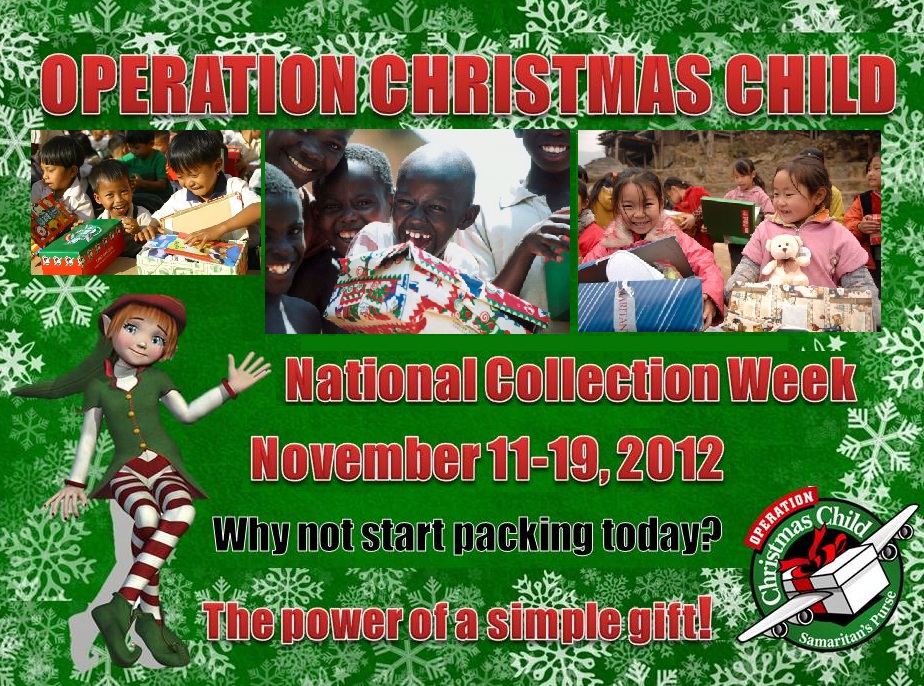 4.) Operation Christmas Child is a family favorite in our home. Every year we fill shoeboxes with small toys, pads of paper, coloring books, crayons, and more for children across the globe. It’s a wonderful Christmas tradition and a beautiful way of keeping the spirit of giving at the center of our celebrations.
4.) Operation Christmas Child is a family favorite in our home. Every year we fill shoeboxes with small toys, pads of paper, coloring books, crayons, and more for children across the globe. It’s a wonderful Christmas tradition and a beautiful way of keeping the spirit of giving at the center of our celebrations.
 5.) Another fun tradition that helps all of us to focus on giving during the holidays is playing ‘Secret Santa.’ I buy dollar store items for each of my children to open before bedtime on the twelve days leading up to Christmas, and they also get twelve dollars to spend on each other for ‘Secret Santa’ gifts. The joy and excitement they get from making each other happy is so touching and a great sibling bonding experience, too!
5.) Another fun tradition that helps all of us to focus on giving during the holidays is playing ‘Secret Santa.’ I buy dollar store items for each of my children to open before bedtime on the twelve days leading up to Christmas, and they also get twelve dollars to spend on each other for ‘Secret Santa’ gifts. The joy and excitement they get from making each other happy is so touching and a great sibling bonding experience, too!
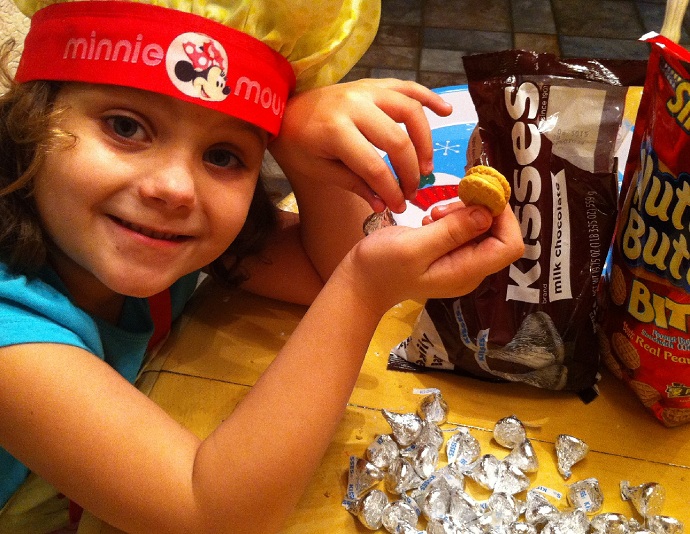
6.) Nursing Home Elves~Many years we’ve gone Christmas caroling at local nursing homes and have always been warmly welcomed by the residents and staff alike. We always bring homemade gifts like cookies, ornaments, or Christmas cards which are a labor of love from my children that bring tears to the eyes of the sweet elderly residents who receive them.
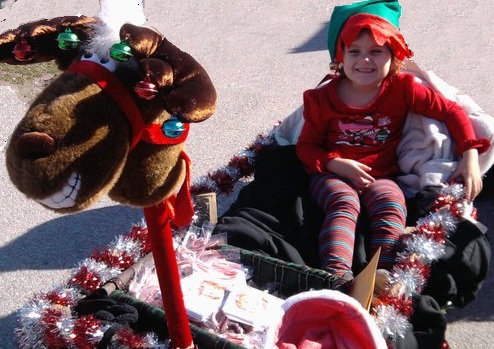 7.) We’ve also participated in special service opportunities such as passing out flyers in our local Christmas parade to help raise funds for a baby in need of a liver transplant and serving dinner to the families of terminally ill children at the Give Kids the World Village in a nearby city.
7.) We’ve also participated in special service opportunities such as passing out flyers in our local Christmas parade to help raise funds for a baby in need of a liver transplant and serving dinner to the families of terminally ill children at the Give Kids the World Village in a nearby city.
What are some ways your family focuses on giving during the holidays or year round?
Related posts:
Celebrating Jesus with a Santa Claus Christmas
24 Tips for a Safe, Stress-Free & Jolly Holiday… A Very Toddler Christmas
200 Ways to Bless Your Children with a Happy Childhood
25 Reasons NOT to Keep Children Busy
Fairy Tales~The Lost Value of ‘Once upon a time…’
The Seven Wonders of the World of Childhood
 Award-winnning author, L.R.Knost, is the founder and director of the children's rights advocacy and family consulting group, Little Hearts/Gentle Parenting Resources, and Editor-in-Chief of Holistic Parenting Magazine. Books by L.R.Knost include Whispers Through Time: Communication Through the Ages and Stages of Childhood ; Two Thousand Kisses a Day: Gentle Parenting Through the Ages and Stages ; The Gentle Parent: Positive, Practical, Effective Discipline ; and Jesus, the Gentle Parent: Gentle Christian Parenting the first four books in the Little Hearts Handbook gentle parenting series, and children’s picture books Petey’s Listening Ears and the soon-to-be-released Grumpykins series.
Award-winnning author, L.R.Knost, is the founder and director of the children's rights advocacy and family consulting group, Little Hearts/Gentle Parenting Resources, and Editor-in-Chief of Holistic Parenting Magazine. Books by L.R.Knost include Whispers Through Time: Communication Through the Ages and Stages of Childhood ; Two Thousand Kisses a Day: Gentle Parenting Through the Ages and Stages ; The Gentle Parent: Positive, Practical, Effective Discipline ; and Jesus, the Gentle Parent: Gentle Christian Parenting the first four books in the Little Hearts Handbook gentle parenting series, and children’s picture books Petey’s Listening Ears and the soon-to-be-released Grumpykins series.
Changing the World, One Little Heart at a Time
[Portions reprinted from The Gentle Parent: Positive, Practical, Effective Discipline by L.R.Knost. Two Thousand Kisses a Day: Gentle Parenting Through the Ages and Stages and Whispers Through Time: Communication Through the Ages and Stages of Childhood also available on Amazon and through other major retailers.]
~~~~~~~~~~~~~~
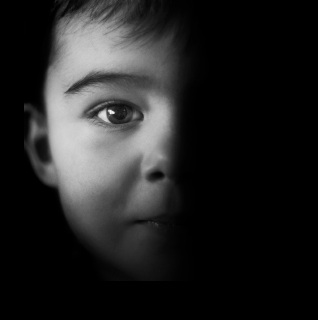 A recent article in the UK based news outlet, The Telegraph, shared a startling image of the differences between the brain of a three-year-old child raised in a nurturing environment and the brain of a three-year-old child who suffered from extreme neglect. The image of the neglected child’s brain lacked “some of the most fundamental areas present” in the image of the nurtured child’s brain. Those areas of deficit included areas determining intelligence, the capacity for self-control, and the ability to empathize. The differences between the two images were so shocking that the neglected three-year-old’s brain looked like one of a victim of brain trauma, but, in this case, it was solely deprivation of a nurturing caregiver that caused the deficiencies.
A recent article in the UK based news outlet, The Telegraph, shared a startling image of the differences between the brain of a three-year-old child raised in a nurturing environment and the brain of a three-year-old child who suffered from extreme neglect. The image of the neglected child’s brain lacked “some of the most fundamental areas present” in the image of the nurtured child’s brain. Those areas of deficit included areas determining intelligence, the capacity for self-control, and the ability to empathize. The differences between the two images were so shocking that the neglected three-year-old’s brain looked like one of a victim of brain trauma, but, in this case, it was solely deprivation of a nurturing caregiver that caused the deficiencies.
“Professor Allan Schore, of UCLA, who has surveyed the scientific literature and has made significant contributions to it, stresses that the growth of brain cells is a ‘consequence of an infant’s interaction with the main caregiver [usually the mother].’ The growth of the baby’s brain ‘literally requires positive interaction between mother and infant. The development of cerebral circuits depends on it.’”
The article goes on to discuss the fact that eighty percent of the brain cells that will develop in a person’s lifetime are created in the first two years, making any significant recovery of potential after that period difficult to impossible. “If the process of building brain cells and connections between them goes wrong, the deficits are permanent.”
While it may be hard to grasp the idea of permanent brain damage as a result of poor parenting, scientists have known as far back as the Harry Harlow studies on primates in 1957 and the world has seen in the heartbreaking images of the neglect in the 1990 expose of the Romanian orphanage system that a nurturing, care-giving environment is essential to normal intellectual, emotional, and social development.
“This discovery has enormous implications for social policy. It explains two very persistent features of our society…Chronic disadvantage reproduces itself across generations of the same families. There is a cycle of deprivation – lack of educational attainment, persistent unemployment, poverty, addiction, crime – which, once a family is in it, has proved almost impossible to break…Parents who, because their parents neglected them, do not have fully developed brains, neglect their own children in a similar way: their own children’s brains suffer from the same lack of development that blighted their own lives. They, too, are likely to fail at school, to be liable to get addicted to drugs, to be unable to hold down a job, and to have a propensity to violence.
The second persistent feature is the dismal failure of rehabilitation programmes that aim to diminish the rate at which persistent young offenders commit crimes. Many different approaches have been tried, from intensive supervision to taking young offenders on safaris, but none has worked reliably or effectively. Recent research indicates that a large majority – perhaps more than three quarters – of persistent young offenders have brains that have not developed properly. They have, that is, suffered from neglect in the first two years of life, which prevented their brains from growing.”
Decades of research, not to mention simple human experience, have confirmed the importance of an interactive, attentive, and responsive primary caregiver in early childhood. And yet, unlike the more family-centered societies in third world countries, most industrialized societies have embraced a far more detached parenting mode typified by practices such as sleep-training, schedule-based feeding, non-family care-giving, etc.
Additionally, public policies in the most advanced nations on earth tend to be skewed significantly toward housing the results of childhood neglect in prisons and homeless shelters rather than addressing the root issues of that neglect. Tax codes favor two-career families, thus making it more difficult for a parent to choose to remain at home and provide a stable, nurturing environment. Public funds are poured into educating parents about public health concerns like obesity and smoking and vaccinations rather than into early parenting support such as breastfeeding education and crisis resources and information on normal child development and behavior.
The lost potential in the lives of these children and the resultant social issues because of short-sighted public policies is as unconscionable as it is unnecessary. Public attitudes must shift from “somebody should do something” to “let’s address this together,” and we need to go further than just reaching out to troubled children. While that is a vital step, and nurturing from another family member or a mentor can have a significant positive influence on a troubled child, that influence may be limited by brain deficiencies and associated negative behavioral patterns already in place due to neglect.
Let’s also go back to the beginning, though, and address the issues preemptively. Let’s reach out to families in need with our hearts instead of just our tax dollars. Let’s be the change we want to see in the world by mentoring struggling parents in our communities, organizing local outreaches such as parenting fairs, and supporting community centers and churches that provide weekly mommy and me classes or mom’s day out resources. Let’s provide schools with information packets about optimal early childhood care to send home with students with new babies in their families.
Let’s contact our local universities and ask them to consider giving college credit for early education/social work/nursing students, etc. to spend a certain number of hours every week mentoring at-risk new mothers. Let’s contact our government officials and petition them to implement tax breaks and incentives to stay-at-home parents with young children and to employers to encourage them to offer extended maternity leaves.
The research has been done. The reports have been written. The evidence is clear. Parents matter. Parenting choices have a profound impact on children and the people they will become, and the people they become will shape the world we all share.
Join Little Hearts/Gentle Parenting Resources in changing the world, one little heart at a time. ♥
*Also published in The Natural Parent Magazine
Related posts:
Practical, Gentle, Effective Discipline
200 Ways to Bless Your Children with a Happy Childhood
12 Tips for Gently Parenting Your Adult Children (Hint: It starts when they’re newborns!)
The Measure of Success~Chinese Parents and French Parents Can’t BOTH Be Superior!
 Award-winnning author, L.R.Knost, is the founder and director of the children's rights advocacy and family consulting group, Little Hearts/Gentle Parenting Resources, and Editor-in-Chief of Holistic Parenting Magazine. Books by L.R.Knost include Whispers Through Time: Communication Through the Ages and Stages of Childhood ; Two Thousand Kisses a Day: Gentle Parenting Through the Ages and Stages ; The Gentle Parent: Positive, Practical, Effective Discipline ; and Jesus, the Gentle Parent: Gentle Christian Parenting the first four books in the Little Hearts Handbook gentle parenting series, and children’s picture books Petey’s Listening Ears and the soon-to-be-released Grumpykins series.
Award-winnning author, L.R.Knost, is the founder and director of the children's rights advocacy and family consulting group, Little Hearts/Gentle Parenting Resources, and Editor-in-Chief of Holistic Parenting Magazine. Books by L.R.Knost include Whispers Through Time: Communication Through the Ages and Stages of Childhood ; Two Thousand Kisses a Day: Gentle Parenting Through the Ages and Stages ; The Gentle Parent: Positive, Practical, Effective Discipline ; and Jesus, the Gentle Parent: Gentle Christian Parenting the first four books in the Little Hearts Handbook gentle parenting series, and children’s picture books Petey’s Listening Ears and the soon-to-be-released Grumpykins series.
Celebrating Jesus with a Santa Claus Christmas
[By L.R.Knost, best-selling author of The Gentle Parent: Positive, Practical, Effective Discipline, Whispers Through Time: Communication Through the Ages and Stages of Childhood and Two Thousand Kisses a Day: Gentle Parenting Through the Ages and Stages available on Amazon and through other major retailers.]
*********************
***I Believe in Santa Claus***
 Who does this describe?
Who does this describe?
- A bearded, good-hearted man
- A generous man who is well-known for giving to others
- A gentle man who is often pictured welcoming smiling children
- A man who, it is said, “sees you when you’re sleeping. He knows when you’re awake. He knows if you’ve been bad or good…”
- A man we believe in without ever having to see
- A man with amazing, awe-inspiring ‘magical’ powers
If you answered ‘Santa Claus,’ you’re right! If you answered ‘Jesus,’ you’re right, too! The parallels are striking, aren’t they? And with good reason…
One is the symbol of the Christmas season. The other is the reason for it. One is the parable. The other is the reality.
“I, like many new parents, struggled with the idea of perpetuating a ‘false belief’ and thus undermining my children’s trust. But then I turned to the Bible and saw how Jesus, who spoke absolute truth always, often spoke that truth in parables. He knew something about people’s hearts that I needed to learn as a young parent. He knew that the human mind is logic, analysis, reason, and that the human heart is imagination, creativity, love. He knew that sometimes you have to bypass people’s minds and speak straight to their hearts, those well-springs of wonder, for true understanding to occur and that often the deepest truths are the ones that are too big for the human mind to receive and can only be grasped by the heart.” [The Great Santa Claus Debate]
Flights of fantasy, wonder, and awe are vehicles through which all of us, not only children, can grasp the inexplicable, understand the unimaginable, embrace the extraordinary.
I want my children to dance with excitement as the Christmas season begins with the ringing sound of carols and the glitter of decorations filling our home. I want them to wonder and imagine as we read Christmas stories and watch Christmas classics together under warm blankets with bowls of buttery popcorn and piping hot mugs of hot cocoa. I want them to gasp in awe at the brilliant abundance of presents under the Christmas tree as we gather on Christmas morning and sing ‘Happy Birthday to Jesus’ before the tumble-bumble, joyful chaos of gift opening begins.
I want these things for them so that as they grow up they’ll take these memories of joy and laughter and wonder and awe with them and always be able feel the beauty of the Gift we were given in the Christ Child instead of just having head knowledge of Him.
“I chose the way of the parable. I embraced Christmas in all its glory, decorated and baked and showered my little ones with gifts, all while sharing the story of the birth of a Baby. Woven through every event, every tradition, every memorable moment of our family’s Christmas, is the celebration of the wondrous gift of a Savior. We watch Rudolph the Red-Nosed Reindeer, Santa Claus is Coming to Town, and all the other fun Christmas shows together. We read bedtime stories about Christmas elves and magical toys and talking animals. And when my children ask me if Santa really exists, I tell them “Yes,” because it’s true. Every parent who carries on St. Nicholas’ tradition of leaving secret gifts, of being the heart and hands of Jesus, of sharing the wonder, excitement, and glory of the most extraordinary Gift ever given to mankind, every one of us is Santa Claus.”
I believe in Santa Claus because I am Santa Claus!
That, to me, is the true reason for the season~sharing the truth of the most unimaginable, unattainable, unfathomable Gift ever given, and the way we choose to do that in our family is to celebrate Jesus with a Santa Claus Christmas.
How does your family celebrate the holidays?
[Click here for more ideas about how to keep a spirit of giving at the center of your family’s Christmas celebrations. Happy Holidays!]
This video of Kenny Rogers and Dolly Parton singing ‘I Believe in Santa Claus’ makes me cry every time I see it.
Related posts:
The Spirit of Christmas… The Great Santa Claus Debate
24 Tips for a Safe, Stress-Free & Jolly Holiday… A Very Toddler Christmas
Making gratitude and generosity a standard of life… 7 Tips and Traditions to Make Giving a Standard of Living
A happy childhood sends a child into adulthood with a baggage of confidence and kindness instead of disillusionment and anger. 200 Ways to Bless Your Children with a Happy Childhood
The human brain needs time to process, categorize, prioritize, analyze, and otherwise make sense of all of the trillions of bits of information that it receives each day. Non-structured playtime for children functions much like sleep does for adults, giving their brains the time and space they need to move short-term memory to long-term learning. 25 Reasons NOT to Keep Children Busy
In the world of a child wonders are as simple as sticks and sheets, leaves and books, boxes and giggles, and the promise in a rainy day. The Seven Wonders of the World of Childhood
Children who love to read…READ! Engaging children’s hearts in the wonder of reading instead of just training their minds in its mechanics. Raising Bookworms
From hitting to defiance to tantrums to testing the boundaries and more, here are gentle parenting tools, tips, and techniques… Practical, Gentle, Effective Discipline
Fairy tales in childhood are stepping stones throughout life, leading the way through trouble and trial. The value of fairy tales lies not in a brief literary escape from reality, but in the gift of hope that goodness truly is more powerful than evil and that even the darkest reality can lead to a Happily Ever After. Fairy Tales~The Lost Value of ‘Once upon a time…’
 Award-winnning author, L.R.Knost, is the founder and director of the children's rights advocacy and family consulting group, Little Hearts/Gentle Parenting Resources, and Editor-in-Chief of Holistic Parenting Magazine. Books by L.R.Knost include Whispers Through Time: Communication Through the Ages and Stages of Childhood ; Two Thousand Kisses a Day: Gentle Parenting Through the Ages and Stages ; The Gentle Parent: Positive, Practical, Effective Discipline ; and Jesus, the Gentle Parent: Gentle Christian Parenting the first four books in the Little Hearts Handbook gentle parenting series, and children’s picture books Petey’s Listening Ears and the soon-to-be-released Grumpykins series.
Award-winnning author, L.R.Knost, is the founder and director of the children's rights advocacy and family consulting group, Little Hearts/Gentle Parenting Resources, and Editor-in-Chief of Holistic Parenting Magazine. Books by L.R.Knost include Whispers Through Time: Communication Through the Ages and Stages of Childhood ; Two Thousand Kisses a Day: Gentle Parenting Through the Ages and Stages ; The Gentle Parent: Positive, Practical, Effective Discipline ; and Jesus, the Gentle Parent: Gentle Christian Parenting the first four books in the Little Hearts Handbook gentle parenting series, and children’s picture books Petey’s Listening Ears and the soon-to-be-released Grumpykins series.






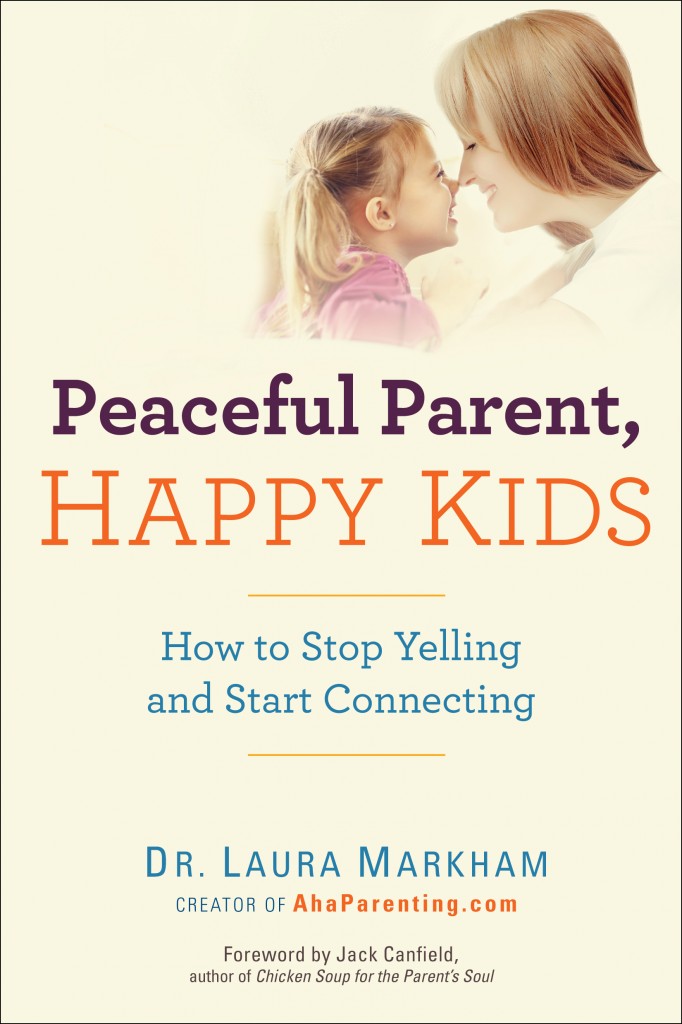
 Dr. Laura Markham trained as a clinical psychologist, but she’s also a mother, so she understands parents as well as kids. Her new book is
Dr. Laura Markham trained as a clinical psychologist, but she’s also a mother, so she understands parents as well as kids. Her new book is 






